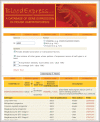BloodExpress: a database of gene expression in mouse haematopoiesis
- PMID: 18987008
- PMCID: PMC2686428
- DOI: 10.1093/nar/gkn854
BloodExpress: a database of gene expression in mouse haematopoiesis
Abstract
Haematopoiesis is the process whereby blood stem cells give rise to at least fourteen functionally distinct mature cell types, and represents the best characterized mammalian adult stem cell system. Here we introduce the BloodExpress database, the first public resource integrating mouse blood cell expression profiles. BloodExpress enables the searching of data from individual studies in a single database accessible through a user-friendly web interface. Microarray datasets have been processed uniformly to allow their comparison on the BloodExpress platform. BloodExpress covers the majority of murine blood cell types, including both progenitors and terminally differentiated cells. This allows for the identification of dynamic changes in gene expression as cells differentiate down the well-defined haematopoietic hierarchy. A gene-centric interface returns haematopoietic expression patterns together with functional annotation and a list of other genes with similar expression patterns. A cell type-centric interface allows the identification of genes expressed at specific points of blood development, with the additional and useful capability of filtering by specific gene functional categories. BloodExpress thus constitutes a platform for the discovery of novel gene functions across the haematopoietic tree. BloodExpress is freely accessible at http://hscl.cimr.cam.ac.uk/bloodexpress/.
Figures



Similar articles
-
Haemopedia RNA-seq: a database of gene expression during haematopoiesis in mice and humans.Nucleic Acids Res. 2019 Jan 8;47(D1):D780-D785. doi: 10.1093/nar/gky1020. Nucleic Acids Res. 2019. PMID: 30395284 Free PMC article.
-
HemaExplorer: a database of mRNA expression profiles in normal and malignant haematopoiesis.Nucleic Acids Res. 2013 Jan;41(Database issue):D1034-9. doi: 10.1093/nar/gks1021. Epub 2012 Nov 9. Nucleic Acids Res. 2013. PMID: 23143109 Free PMC article.
-
BloodSpot: a database of healthy and malignant haematopoiesis updated with purified and single cell mRNA sequencing profiles.Nucleic Acids Res. 2019 Jan 8;47(D1):D881-D885. doi: 10.1093/nar/gky1076. Nucleic Acids Res. 2019. PMID: 30395307 Free PMC article.
-
From haematopoietic stem cells to complex differentiation landscapes.Nature. 2018 Jan 24;553(7689):418-426. doi: 10.1038/nature25022. Nature. 2018. PMID: 29364285 Free PMC article. Review.
-
Dynamic niches in the origination and differentiation of haematopoietic stem cells.Nat Rev Mol Cell Biol. 2011 Sep 2;12(10):643-55. doi: 10.1038/nrm3184. Nat Rev Mol Cell Biol. 2011. PMID: 21886187 Free PMC article. Review.
Cited by
-
BloodSpot: a database of gene expression profiles and transcriptional programs for healthy and malignant haematopoiesis.Nucleic Acids Res. 2016 Jan 4;44(D1):D917-24. doi: 10.1093/nar/gkv1101. Epub 2015 Oct 26. Nucleic Acids Res. 2016. PMID: 26507857 Free PMC article.
-
Genome-wide DNA methylation profiles in hematopoietic stem and progenitor cells reveal overrepresentation of ETS transcription factor binding sites.Genome Res. 2012 Aug;22(8):1407-18. doi: 10.1101/gr.132878.111. Epub 2012 Jun 8. Genome Res. 2012. PMID: 22684279 Free PMC article.
-
Hematopoietic stem cell: self-renewal versus differentiation.Wiley Interdiscip Rev Syst Biol Med. 2010 Nov-Dec;2(6):640-53. doi: 10.1002/wsbm.86. Wiley Interdiscip Rev Syst Biol Med. 2010. PMID: 20890962 Free PMC article. Review.
-
MTD: a mammalian transcriptomic database to explore gene expression and regulation.Brief Bioinform. 2017 Jan;18(1):28-36. doi: 10.1093/bib/bbv117. Epub 2016 Jan 27. Brief Bioinform. 2017. PMID: 26822098 Free PMC article.
-
SyStemCell: a database populated with multiple levels of experimental data from stem cell differentiation research.PLoS One. 2012;7(7):e35230. doi: 10.1371/journal.pone.0035230. Epub 2012 Jul 13. PLoS One. 2012. PMID: 22807998 Free PMC article.
References
Publication types
MeSH terms
Grants and funding
LinkOut - more resources
Full Text Sources
Other Literature Sources

